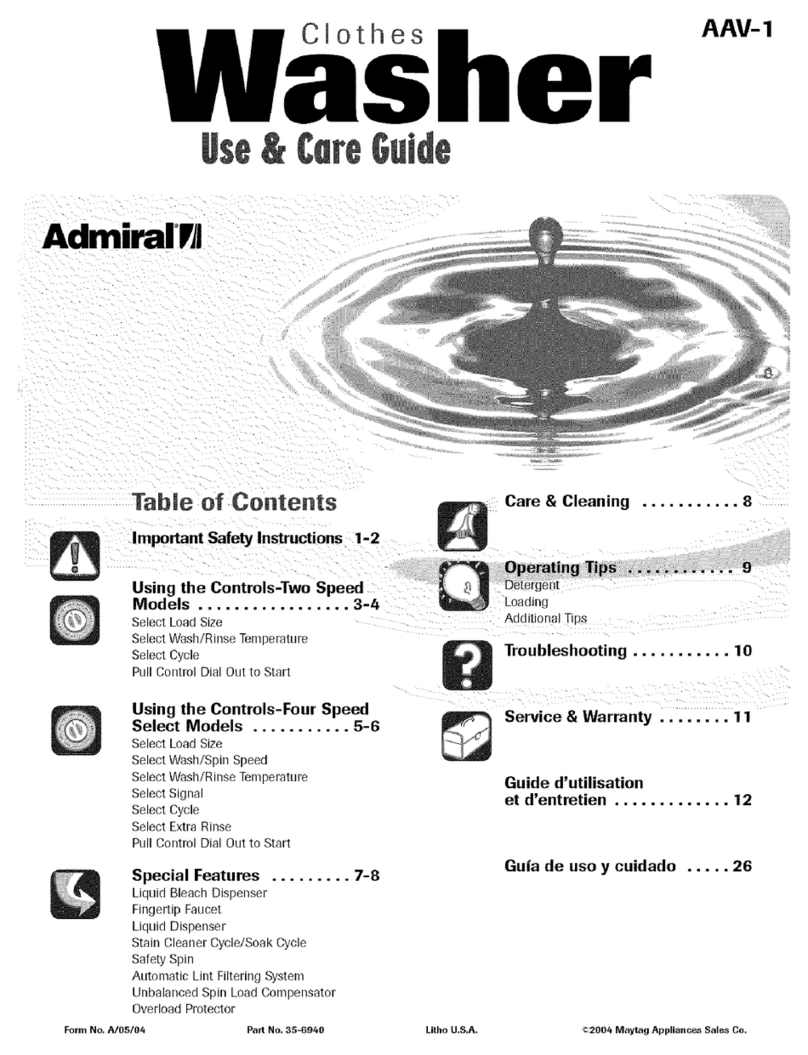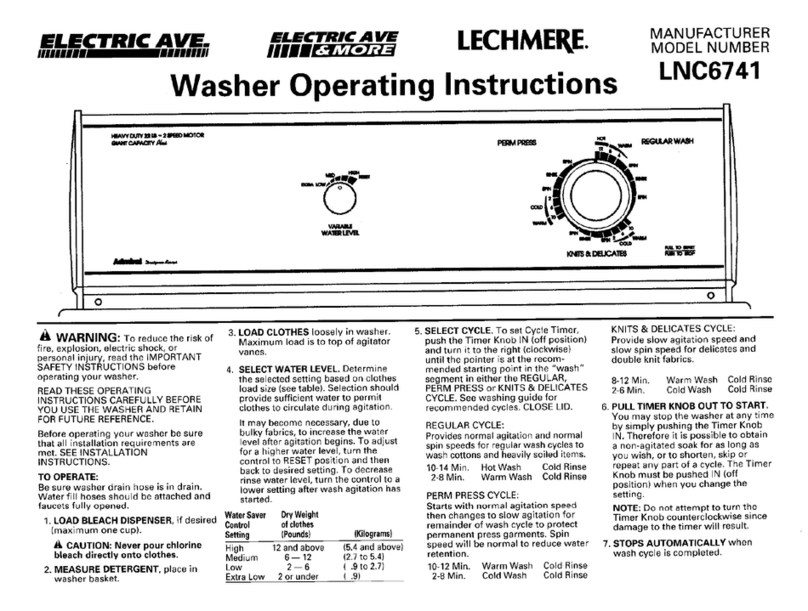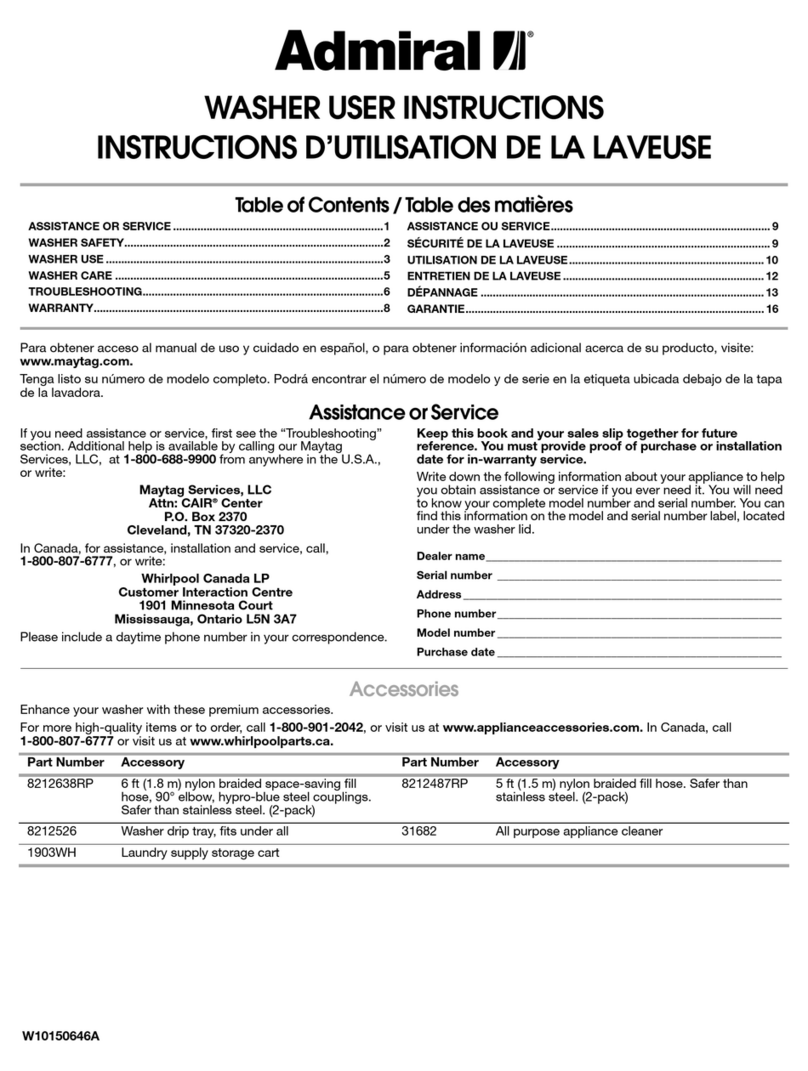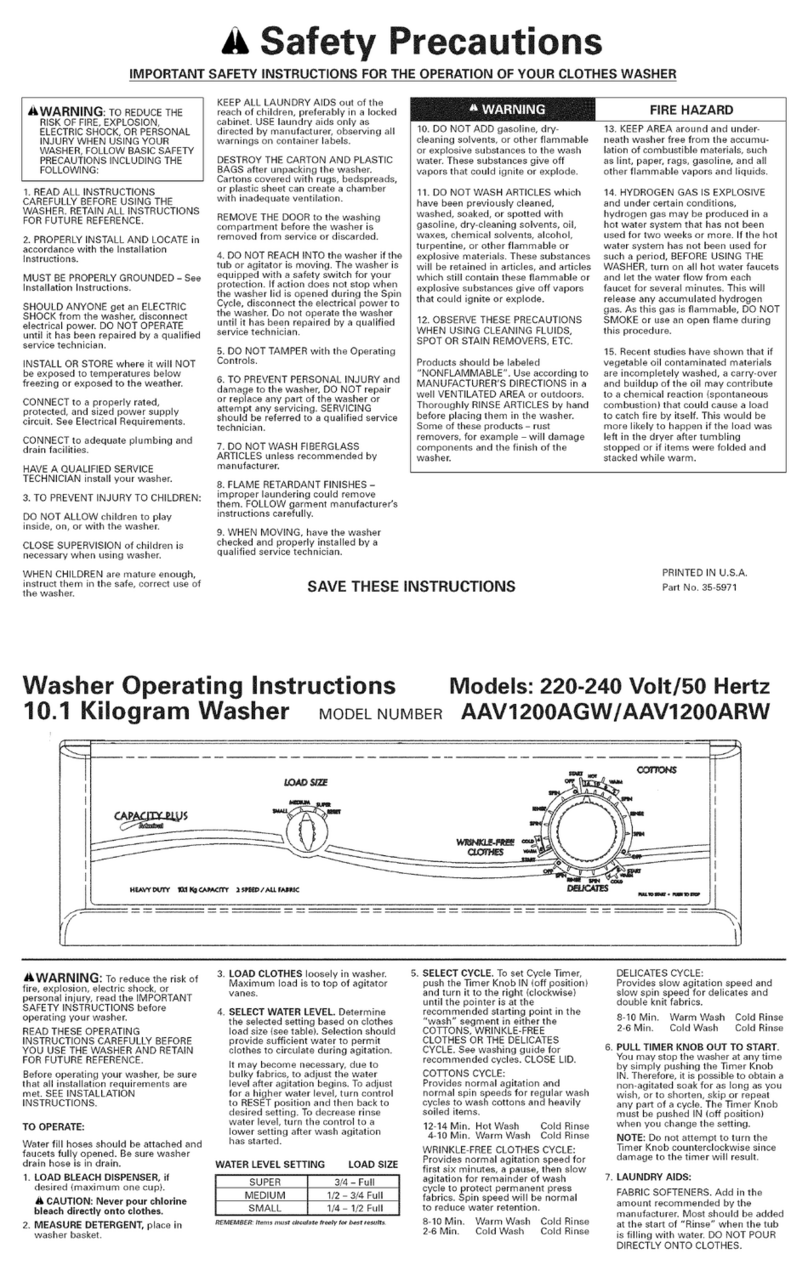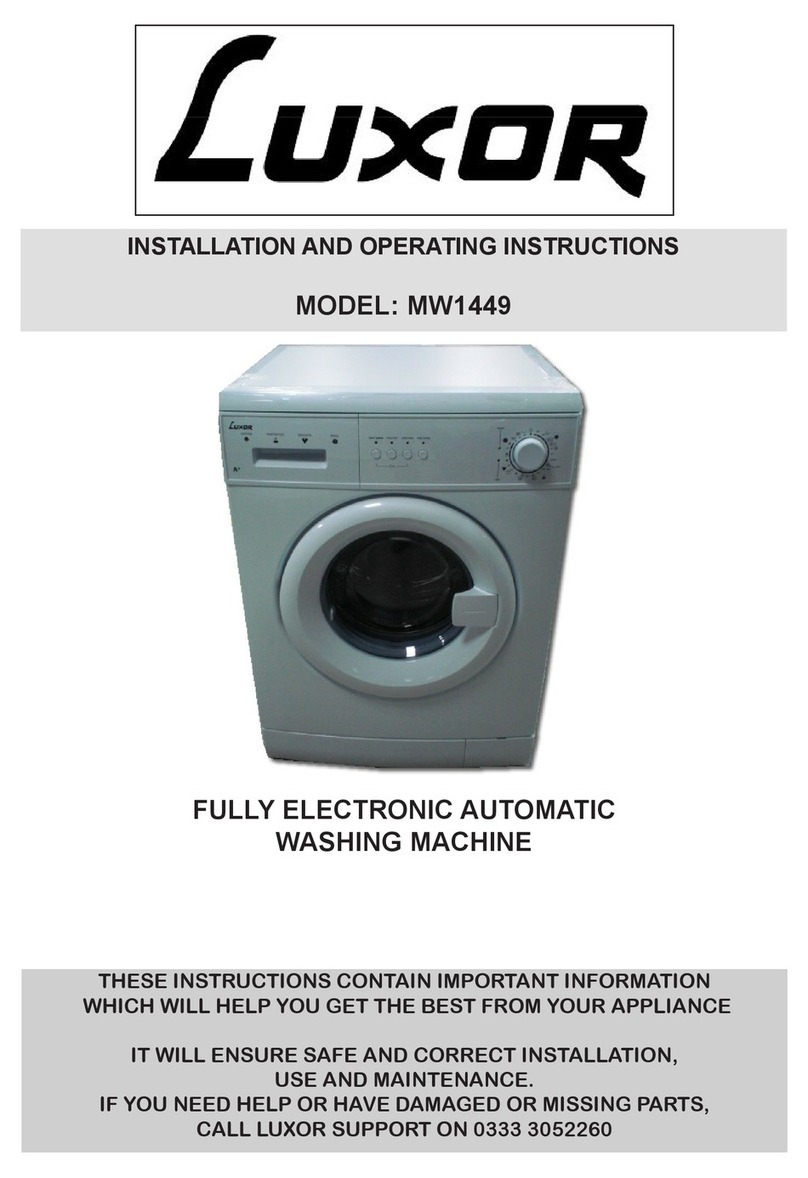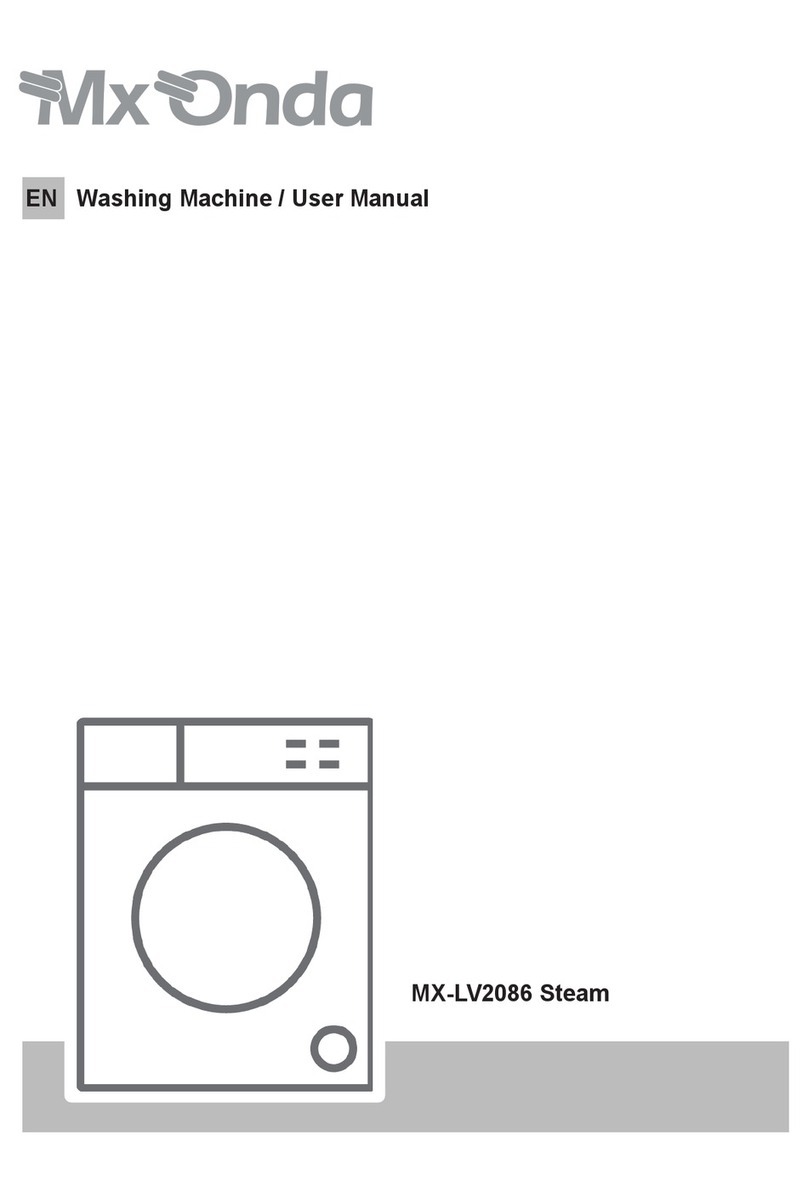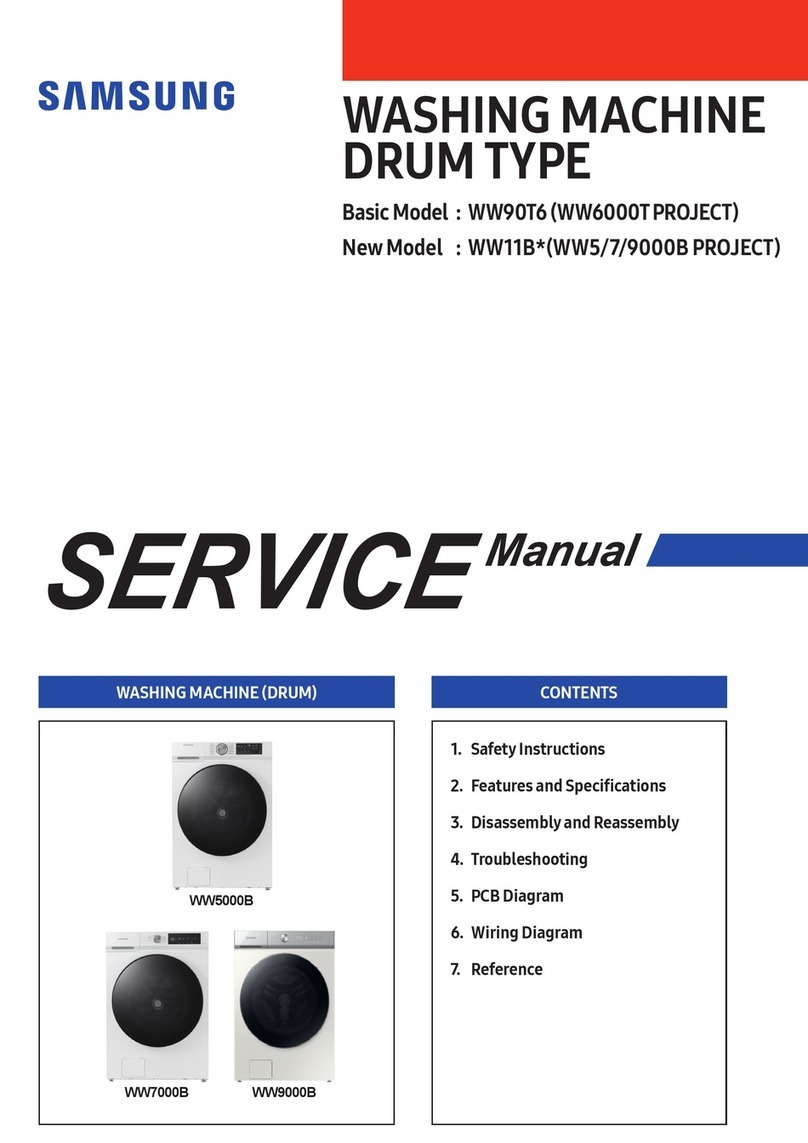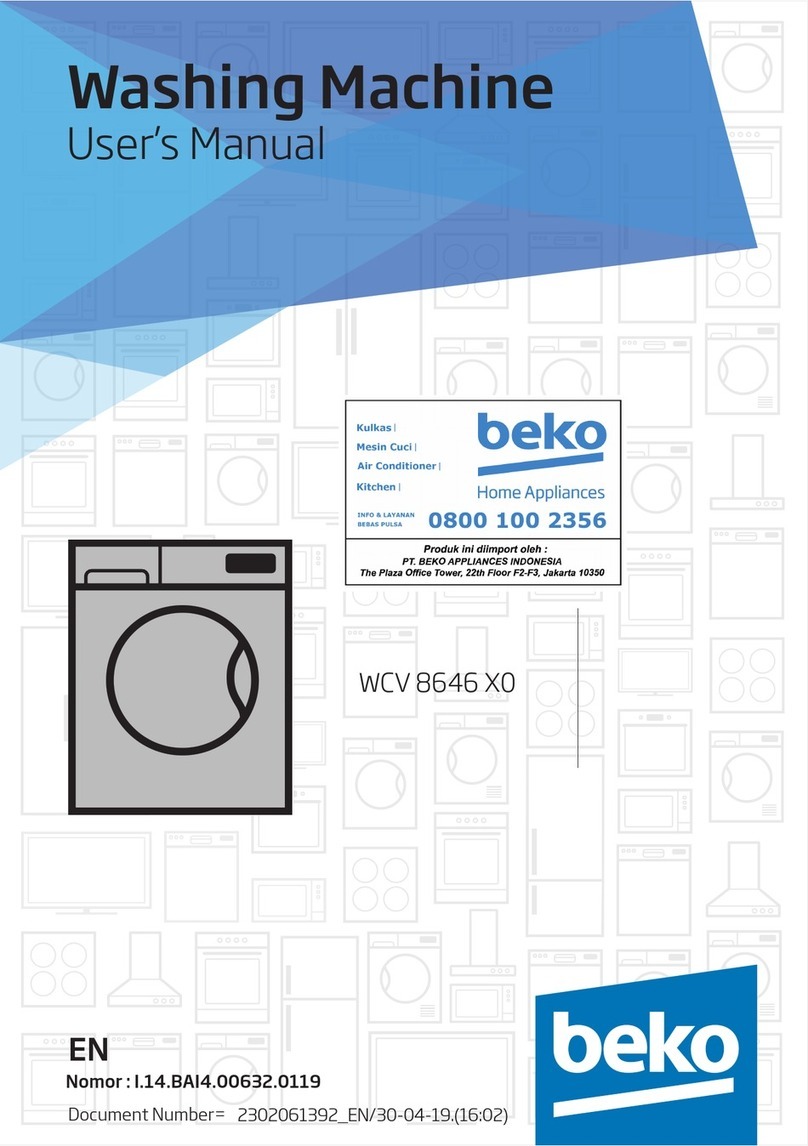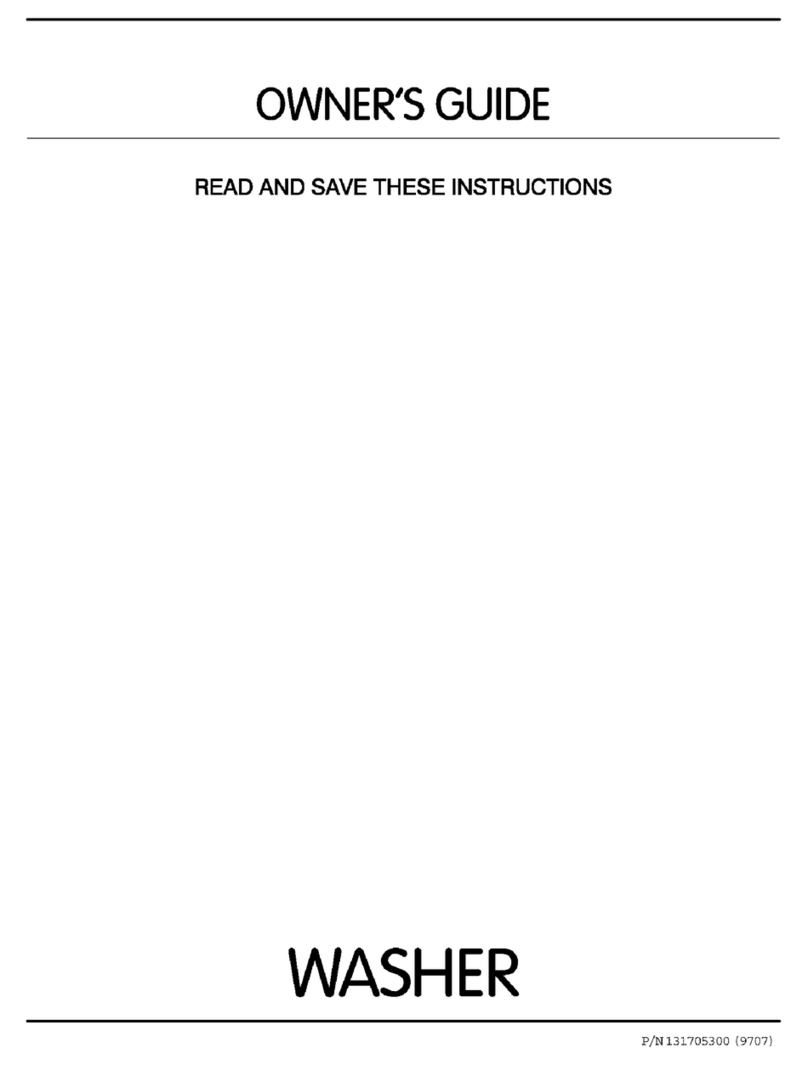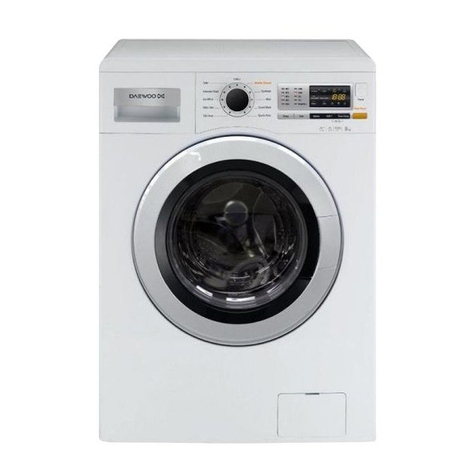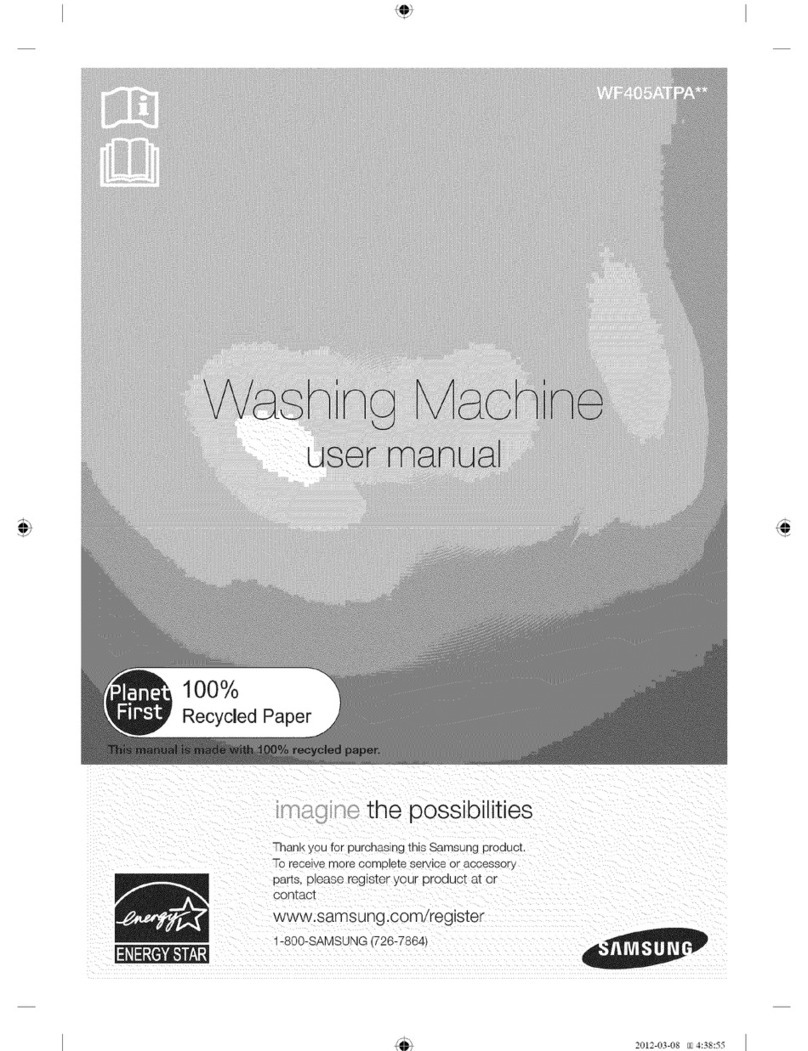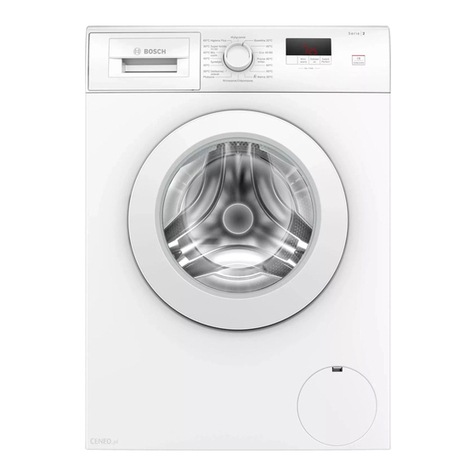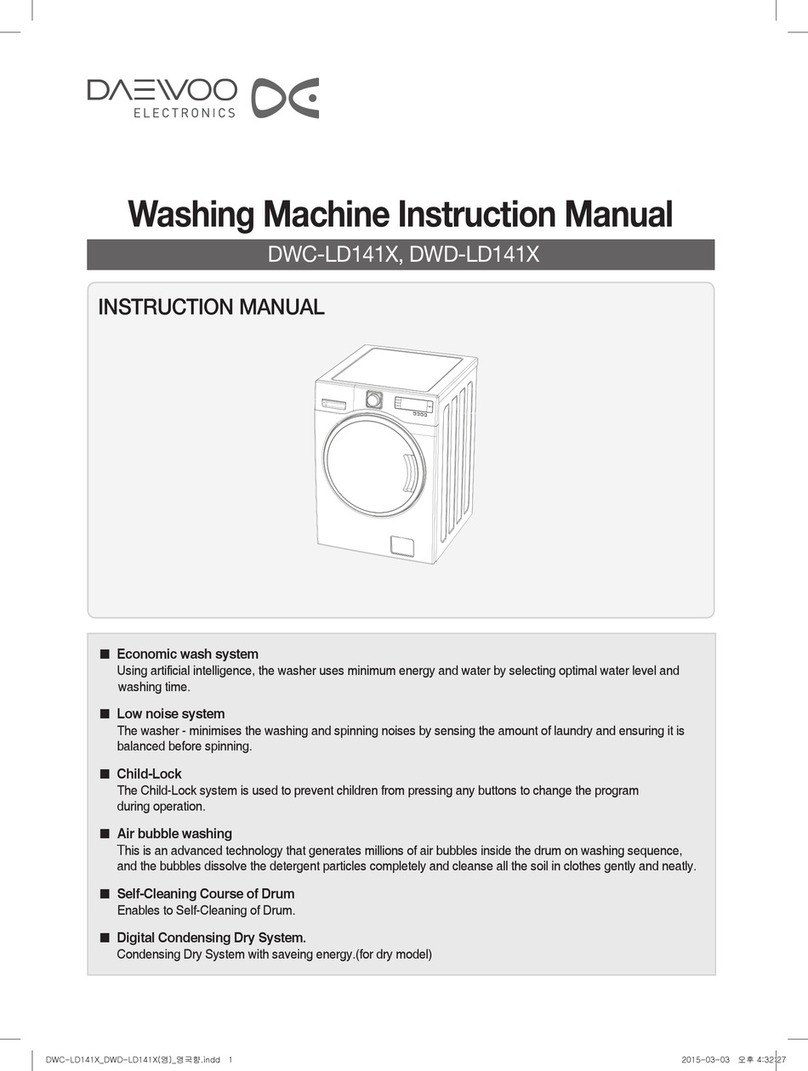Admiral ATW4676BQ0 User manual

W10420470C
W10420471C - SP
Table of Contents
WASHER SAFETY............................................................ 2
WHAT’S NEW UNDER THE LID? .................................... 3
CONTROL PANEL AND FEATURES ............................... 4
CYCLE GUIDE.................................................................. 6
USING YOUR WASHER................................................... 7
WASHER MAINTENANCE............................................... 9
TROUBLESHOOTING.................................................... 11
WARRANTY.................................................................... 15
ASSISTANCE OR SERVICE....................... BACK COVER
Table des matières
SÉCURITÉ DE LA LAVEUSE ......................................... 16
QUOI DE NEUF SOUS LE COUVERCLE? .................... 17
TABLEAU DE COMMANDE
ET CARACTÉRISTIQUES .............................................. 18
GUIDE DE PROGRAMMES ........................................... 20
UTILISATION DE LA LAVEUSE ..................................... 21
ENTRETIEN DE LA LAVEUSE ....................................... 24
DÉPANNAGE .................................................................. 26
GARANTIE...................................................................... 31
ASSISTANCE OU SERVICE.....COUVERTURE ARRIÈRE
Para una versión de estas instrucciones en español, consulte la página de “Ayuda o servicio técnico”.
TOP-LOADING
WASHER
USE AND CARE GUIDE
LAVEUSE À CHARGEMENT
PAR LE DESSUS
GUIDE D’UTILISATION ET
D’ENTRETIEN

2
WASHER SAFETY

3
Lid Locked
To allow for higher spin speeds, the lid will lock and the
Lid Locked light will turn on. When this light is lit, the
lid is locked and cannot be opened. When this light is
blinking, the washer is paused. When this light is off, the
lid can be opened. After a cycle is started, water will enter
washer and then lock. If you need to open the lid to add
a garment after this point, you must press START/Pause/
Unlock Lid and wait for the lid to unlock. The lid will only
unlock after washer movement has stopped. Depending
on when in the cycle you try to pause, it may take several
seconds to several minutes for the lid to unlock. Press
START/Pause/Unlock Lid to resume the cycle.
Sensing
This washer will perform a series of spins to check for load
balance. During this time, a series of clicks and a whirring
noise signal that sensing technology is determining if there
is an off-balance load.
IMPORTANT:
■After the washer basket lls to the selected water level, the lid must be closed before the wash cycle can start.
If lling stops with the lid open, close lid and press START button.
■Fabric Softener option must be set to Yes to ensure fabric softener dispenses at the correct time (on some models).
Sounds
At different stages of the wash cycle, you may hear
sounds and pauses that are different from those of your
previous washer. For example, you may hear a clicking
and hum at the beginning of the cycle as the lid lock
goes through a self-test. There will be different kinds of
humming and whirring sounds as the agitator tests for
load balance or moves the load. And, sometimes, you may
hear nothing at all as the washer allows time for clothes to
soak.
Spray Rinse
Select cycles default to a spray rinse. During these cycles,
you will hear water enter the washer as the tub spins,
allowing the rinse water to penetrate clothes. Check the
“Cycle Guide” for details.
WHAT’S NEW UNDER THE LID?
Your new washer will operate differently than your past agitator-style washer.

4
LOAD SIZE
Select the setting most suitable for your load. Extra Small
or Small (depending on model) will add a low amount of
water for smaller loads and Large will add the most amount
of water for large or bulky loads. Items need to move freely.
Tightly packing can lead to poor cleaning performance, and
may increase wrinkling and tangling.
WASH TEMP or TEMPERATURE
Temperature senses and maintains uniform water
temperatures by regulating incoming hot and cold water.
Select a wash temperature based on the type of fabric
and soils being washed. For best results and following
the garment label instructions, use the warmest wash
water safe for your fabric.
■On some models and cycles, warm and hot water may
be cooler than your previous washer.
■Even in a cold and cool water wash, some warm
water may be added to the washer to maintain
a minimum temperature.
1
2
3
4
FABRIC SOFTENER (on some models)
This option can be added to most cycles and must be set
to YES if using fabric softener during a cycle. It ensures that
fabric softener is added at the correct time in the rinse for
even distribution.
WASH CYCLE KNOB
Use the Wash Cycle knob to select cycles on your washer.
Knob does not advance during the progress of the cycle, see
cycle status lights for each stage of the process. See “Cycle
Guide” for detailed descriptions of cycles.
START/PAUSE/UNLOCK LID BUTTON
Press to start the selected cycle; press again to pause
the cycle and unlock the lid.
NOTE: If the washer is spinning, it may take several
minutes to unlock the lid. Press and hold for 3 seconds
to cancel a cycle.
5
6
42
CONTROL PANEL & FEATURES
Not all features and options are available on all models.
Appearance may vary.
6
5
5
1 3
421

5
6CYCLE STATUS LIGHTS
The Cycle Status Lights show the progress of a cycle.
At each stage of the process, you may notice sounds or
pauses that are different from traditional washers.
FILL
When the START/Pause/Unlock Lid button is pressed,
the washer will ll to the selected water level. If the lid
is closed when the machine is done lling the lid will
lock and the machine will begin operation.
If the lid is open when the water stops entering the
machine, the cycle will not begin until the lid has been
closed and the START/Pause/Unlock Lid button is
pressed. If the cycle has not been started within
10 minutes of the water lling the washer, the washer
will pump out the water.
NOTE: Avoid opening lid during sensing phase. The
sensing process will start over when the washer is
restarted. The ll light may also come on during
the Soak and Wash portions of the cycle. This is
normal. To restart the washer after the lid has been
opened press start.
WASH
You will hear the agitator moving the load. The motor
sounds may change at different stages in the cycle.
The wash time is determined by the selected soil level.
RINSE
You will hear sounds similar to the wash cycle as the washer
rinses and moves the load. You may hear the motor turning
on briey (short hum) to move the basket while lling. Fabric
softener will be added if the Fabric Softener knob was set to
YES.
Some cycles use spray rinsing. After draining and spinning
out wash water, the washer will continue to spin and spray
in rinse water for the entire rinse time.
FINAL SPIN
The washer spins the load at increasing speeds for proper
water removal, based on the selected cycle and spin speed.
CYCLE COMPLETE
Once the cycle is complete, this light will come on.
Remove the load promptly for best results.
LID LOCKED
To allow for higher spin speeds, the lid
will lock and the Lid Locked light will turn
on. When this light is on, the lid is locked
and cannot be opened. When this light is
blinking, the washer is paused. When this
light is off, the lid can be opened.
If you need to open the lid, press START/
Pause/Unlock Lid. The lid will unlock once
the washer movement has stopped. This
may take several minutes if the load was
spinning at high speed. Press START/Pause/
Unlock Lid again to resume the cycle.

6
CYCLE GUIDE
For best fabric care, choose the cycle that best ts the load being washed.
Not all cycles and options are available on all models.
NOTE: Be sure to set Fabric Softener knob to YES, if adding fabric softener to load (on some models).
*All rinses are cold.
No-iron fabrics,
cottons, perm
press, linens,
synthetics
Casual
Regular Hot
Warm
Cool
Cold
Low Use this cycle to wash normally soiled loads of no-iron
fabrics such as sport shirts, blouses, casual business
clothes, permanent press, and blends.
No-iron fabrics,
cottons, perm
press, linens,
synthetics
Casual
Medium Hot
Warm
Cool
Cold
Low Use this cycle to wash loads of no-iron fabrics such as sport
shirts, blouses, casual business clothes, permanent press,
and blends.
No-iron fabrics,
cottons, perm
press, linens,
synthetics
Casual
Light Hot
Warm
Cool
Cold
Low Use this cycle to wash lightly soiled loads of no-iron
fabrics such as sport shirts, blouses, casual business
clothes, permanent press, and blends.
Cottons, linens,
towels, sheets, and
mixed garment
loads
Normal
Extra Heavy Hot
Warm
Cool
Cold
High Use this cycle for heavily soiled cottons and mixed fabric
loads. This cycle features a spray rinse. Use this cycle for
cleaning the interior of the washer. See “Washer Care.”
Cottons, linens,
sheets, and mixed
garment loads
Normal
Regular Hot
Warm
Cool
Cold
High Use this cycle for normally soiled cottons and mixed fabric
loads. This cycle features a spray rinse.
Cottons, linens,
sheets, and mixed
garment loads
Normal
Light Hot
Warm
Cool
Cold
High Use this cycle for lightly soiled cottons and mixed fabric
loads. This cycle features a spray rinse.
Machine-wash
silks, hand-washed
fabrics
Delicate
Regular Hot
Warm
Cool
Cold
Low Use this cycle to wash soiled garments indicating “Machine
Washable Silks” or “Gentle” cycle on the care label. Place
small items in mesh garment bags before washing. This
cycle features a spray rinse.
Machine-wash
silks, hand-washed
fabrics
Delicate
Light Hot
Warm
Cool
Cold
Low Use this cycle to wash lightly soiled garments indicating
“Machine Washable Silks” or “Gentle” cycle on the care
label. Place small items in mesh garment bags before
washing. This cycle features a spray rinse.
Small loads of items
labeled “handwash”:
undergarments,
bras, silks
Handwash Hot
Warm
Cool
Cold
Low Similar to the way garments are hand-washed in a sink, this
cycle combines periods of low-speed agitation and soaking.
This cycle features a spray rinse.
NOTE: Use mesh garment bags as needed.
Swimsuits and
garments requiring
rinsing without
detergent
Rinse/Spin Cold rinse only High Combines a rinse and high speed spin for loads requiring
an additional rinse cycle or to complete a load after power
interruption. Also use for loads that require rinsing only.
Hand-washed
garments or
dripping wet items
Drain/Spin N/A High This cycle uses a spin to shorten drying times for heavy
fabrics or special-care items washed by hand. Use this
cycle to drain washer after cancelling a cycle or completing
a cycle after a power failure.
Items to wash: Cycle: Wash
Temperature*: Spin
Speed: Cycle Details:

7
Electrical Shock Hazard
Plug into a grounded 3 prong outlet.
Do not remove ground prong.
Do not use an adapter.
Do not use an extension cord.
Failure to follow these instructions can result in death,
re, or electrical shock.
WARNING
■Empty pockets. Loose change, buttons, or any small object
can pass under the agitator and become trapped, causing
unexpected sounds.
■Sort garments by recommended cycle, water temperature,
and colorfastness.
■Separate heavily soiled garments from lightly soiled.
■Separate delicate garments from sturdy fabrics.
■Do not dry garments if stains remain after washing, because
heat can set stains into fabric.
■Treat stains promptly.
■Close zippers, fasten hooks, tie strings and sashes, and
remove non-washable trim and ornaments.
■Mend rips and tears to avoid further damage to garments
during washing.
Helpful Tips:
■When washing water-proof or water-resistant items, load
evenly.
■Use mesh garment bags to help avoid tangling when washing
delicate or small garments.
■Turn knits inside out to avoid pilling. Separate lint-takers from
lint-givers. Synthetics, knits, and corduroy fabrics will pick up
lint from towels, rugs, and chenille fabrics.
NOTE: Always read and follow fabric care label instructions to
avoid damage to your garments.
1. Sort and prepare your laundry
USING YOUR WASHER
Add a measured of amount of detergent or single-dose
laundry packet into the basket.
If using Oxi-type boosters, color-safe bleach, or fabric
softener crystals, add to the bottom of the washer basket
before adding clothes.
NOTE: Follow the manufacturer’s instructions to determine
the amount of laundry products to use.
2.Add laundry products

8
5. Add fabric softener to dispenser
(on some models)
Pour a measured amount of liquid fabric
softener into dispenser; always follow
manufacturer’s directions for correct amount
of fabric softener based on your load size.
IMPORTANT:
•Dilute liquid fabric softener by lling the
dispenser with warm water until liquid
reaches the underside of the rim. See Max
Fill line arrows. Then set Fabric Softener
option knob to YES.
•Fabric Softener option knob must be set to
YES to ensure proper distribution at correct
time in cycle.
Adding Liquid Fabric Softener Manually to Wash Load
During the nal rinse, wait until the washer has completed lling,
press the START/Pause/Unlock Lid button to pause the washer.
Lift the lid and add the measured recommended amount of liquid
fabric softener. Do not use more than the recommended amount.
Close the lid and press the START/Pause/Unlock Lid button again
to start the washer.
4. Add liquid chlorine bleach to
dispenser
Liquid
Chlorine Bleach
Do not overll, dilute, or use more than 1 cup (250 mL).
Do not use color-safe bleach or Oxi products in the same
cycle with liquid chlorine bleach.
3. Load laundry into washer
MAX FILL
Turn cycle knob to choose your wash cycle. For more
information, see “Cycle Guide”.
6.Select CYCLE
Load garments in loose heaps evenly
around basket wall. For best results, do
not pack the load tightly. Do not wrap
large items such as sheets around the
agitator; load them in loose piles around
the sides of the basket. Try mixing
different sized items to reduce tangling.
IMPORTANT: Do not tightly pack or force items into washer.
Items need to move freely for best cleaning and to reduce
wrinkling and tangling.

9
Select the Load Size setting most suitable for your load. Extra
small or small will add a low amount of water for smaller loads
and Large will add the most amount of water for large or bulky
loads. Garments need to move freely.
7.Select LOAD SIZE
8. Select WASH TEMP/
TEMPERATURE
Once you select a cycle, select the desired temperature by
turning the Wash Temp/Temperature knob to the appropriate
setting based on your load. All rinses are cold.
NOTE: Always read and follow fabric care label instructions to
avoid damage to your garments.
If you are using fabric softener, be sure to set the Fabric
Softener option knob to YES.
9.Select options, if desired (on some
models)
10. Press START/Pause/Unlock Lid
to begin wash cycle
Press the START/Pause/Unlock Lid button to start the wash
cycle. When the cycle has nished, the CYCLE COMPLETE
indicator will light. Promptly remove garments after cycle has
completed to avoid odor, reduce wrinkling, and rusting of
metal hooks, zippers, and snaps.
Unlocking the lid to add garments
If you need to open the lid to add 1 or 2 missed garments:
Press START/Pause/Unlock Lid; the lid will unlock once
the washer movement has stopped. This may take several
minutes if the load was spinning at high speed. Then close
lid and press START/Pause/Unlock Lid again to restart
the cycle.
If lid is left open for more than 10 minutes, the water will
pump out automatically.
Wash Temp/Temperature Suggested Fabrics
Hot
Some cold water is added to save
energy. This will be cooler than
your hot water heater setting.
Whites and pastels
Durable garments
Heavy soils
Warm
Some cold water will be added, so
this will be cooler than what your
previous washer provided.
Bright colors
Moderate to light soils
Cool
Warm water may be added to
assist in soil removal and to help
dissolve detergents.
Colors that bleed
or fade
Light soils
Cold
This is the temperature from your
faucet. If your tap cold water is
very cold, warm water may be
added to assist in soil removal
and help dissolve detergent.
Dark colors that
bleed or fade
Light soils
WASHER MAINTENANCE
Replace inlet hoses after 5 years of use to reduce the risk
of hose failure. Periodically inspect and replace inlet hoses
if bulges, kinks, cuts, wear, or leaks are found.
When replacing your inlet hoses, mark the date of
replacement on the label with a permanent marker.
NOTE: This washer does not include inlet hoses. See the
“Installation Instructions” for more information.
WATER INLET HOSES

10
Operate your washer only when you are home. If moving, or
not using your washer for a period of time, follow these steps:
1. Unplug or disconnect power to washer.
2. Turn off water supply to washer, to avoid ooding due to
water pressure surge.
WINTER STORAGE CARE
IMPORTANT: To avoid damage, install and store washer
where it will not freeze. Because some water may stay in
hoses, freezing can damage washer. If storing or moving
during freezing weather, winterize your washer.
To winterize washer:
1. Shut off both water faucets; disconnect and drain water
inlet hoses.
2. Put 1 qt. (1 L) of R.V.-type antifreeze in basket and run
washer on RINSE/SPIN cycle for about 30 seconds to
mix antifreeze and remaining water.
3. Unplug washer or disconnect power.
NON-USE AND VACATION CARE
TRANSPORTING YOUR WASHER
1. Shut off both water faucets. Disconnect and drain water
inlet hoses.
2. If washer will be moved during freezing weather, follow
“Winter Storage Care” directions before moving.
3. Disconnect drain from drain system and drain any
remaining water into a pan or bucket. Disconnect drain
hose from back of washer.
4. Unplug power cord.
5. Place inlet hoses and drain hose inside washer basket.
6. Drape power cord over edge and into washer basket.
7. Place packing tray from original shipping materials back
inside washer. If you do not have packing tray, place heavy
blankets or towels into basket opening. Close lid and place
tape over lid and down front of washer. Keep lid taped until
washer is placed in new location.
WASHER CARE
Recommendations to Help Keep Your Washer Clean and
Performing at its Best
1. Always follow the detergent manufacturer’s instructions
regarding the amount of detergent to use. Never use more
than the recommended amount because that may increase
the rate at which detergent and soil residue accumulate
inside your washer, which in turn may result
in undesirable odor.
2. Use warm and hot wash water settings sometimes (not
exclusively cold water washes), because they do a better
job of controlling the rate at which soils and detergent
accumulate.
3. Always leave the washer lid open between uses to help dry
out the washer and prevent the buildup of odor-causing
residue.
Cleaning Your Top Loading Washer
Read these instructions completely before beginning the
routine cleaning processes recommended below. This Washer
Maintenance Procedure should be performed, at a minimum,
once per month or every 30 wash cycles, whichever occurs
sooner, to control the rate at which soils and detergent may
otherwise accumulate in your washer.
Cleaning the Inside of the Washer
To keep your washer odor-free, follow the usage instructions
provided above, and use this recommended monthly cleaning
procedure:
Recommended Cycle for Cleaning the Washer
Refer to the “Cycle Guide” for the optimal cycle for cleaning
the inside of the washer. Use this cycle with affresh®Washer
Cleaner or liquid chlorine bleach as described below.
Begin procedure
1. affesh®Washer Cleaner Cycle Procedure
(Recommended for Best Performance):
a. Open the washer lid and remove any clothing or items.
b.Place an affesh®Washer Cleaner tablet in the bottom
of the washer basket.
c. Do not place an affresh®Washer Cleaner tablet
in the detergent dispenser.
d.Do not add any detergent or other chemical to the
washer when following this procedure.
e. Close the washer lid.
f. Select the cycle recommended for cleaning the inside
of the washer.
g.Press the START/Pause/Unlock Lid button to start the
cycle.
NOTE: For best results, do not interrupt cycle. If cycle
must be interrupted, press START/Pause/Unlock Lid
once or twice (depending on model). After the cycle has
stopped, run a RINSE/SPIN cycle to rinse cleaner from
washer.
2. Chlorine Bleach Procedure (Alternative):
a. Open the washer lid and remove any clothing or items.
b. Add 1 cup (236 mL) of liquid chlorine bleach
to the bleach compartment.
NOTE: Use of more liquid chlorine bleach than is
recommended above could cause washer damage
over time.
c. Close the washer lid.
d. Do not add any detergent or other chemical
to the washer when following this procedure.
e. Select the cycle recommended for cleaning the inside
of the washer.
WASHER CARE (cont.)
f. Press the START/Pause/Unlock Lid button to start the
cycle.
NOTE: For best results, do not interrupt cycle. If cycle
must be interrupted, press START/Pause/Unlock Lid
once or twice (depending on model). After the cycle has
stopped, run a RINSE/SPIN cycle to rinse cleaner from
washer.
Cleaning the Dispensers
After a period of using your washer, you may nd some
residue buildup in the washer’s dispensers. To remove
residue from the dispensers, wipe them with a damp cloth
and towel dry. Do not attempt to remove the dispensers or
trim for cleaning. The dispensers and trim are not removable.
If your model has a dispenser drawer, however, remove the
drawer and clean it before or after you run the Clean Washer
cycle. Use an all-purpose surface cleaner, if needed.
Cleaning the Outside of the Washer
Use a soft, damp cloth or sponge to wipe away any spills.
Use only mild soaps or cleaners when cleaning external
washer surfaces.
IMPORTANT: To avoid damaging the washer’s nish, do not
use abrasive products.

11
REINSTALLING/USING WASHER AGAIN
To reinstall washer after non-use, vacation, winter storage,
or moving:
1. Refer to “Installation Instructions” to locate, level, and
connect washer.
2. Before using again, run washer through the following
recommended procedure:
To use washer again:
1. Flush water pipes and hoses. Reconnect water inlet hoses.
Turn on both water faucets.
2. Plug in washer or reconnect power.
3. Run washer through Casual Regular cycle to clean washer
and remove antifreeze, if used. Use half the manufacturer’s
recommended amount of detergent for a medium-size load.
Electrical Shock Hazard
Plug into a grounded 3 prong outlet.
Do not remove ground prong.
Do not use an adapter.
Do not use an extension cord.
Failure to follow these instructions can result in death,
re, or electrical shock.
WARNING
TROUBLESHOOTING
If you experience Possible Causes Solution
Vibration or Off-Balance
Check the following for
proper installation or see
“Using Your Washer”
section
Feet may not be in contact with the
oor and locked. Front and rear feet must be in rm contact with oor, and washer
must be level to operate properly.
Washer may not be level. Check oor for exing or sagging. If ooring is uneven, a 3/4"
(19 mm) piece of plywood under your washer will reduce sound.
See “Level the Washer” in Installation Instructions.
Load could be unbalanced. Load dry garments in loose heaps evenly around basket wall.
Adding wet garments to washer or adding more water to basket
could unbalance washer.
Wash smaller loads to reduce imbalance.
Do not tightly pack. Avoid washing single garments.
Use the Normal Regular cycle and select Large Load Size for
oversized, non-absorbent garments such as comforters or
poly-lled jackets.
See “Cycle Guide” and “Using Your Washer.”
Noises
Clicking or
metallic noises Objects caught in washer
drain system. Empty pockets before washing. Loose items such as coins
could fall between basket and tub or may block pump. It may be
necessary to call for service to remove items.
It is normal to hear metal items on clothing such as metal snaps,
buckles, or zippers touch against the basket.
Gurgling or humming Washer may be draining water. It is normal to hear the pump making a continuous humming
sound with periodic gurgling or surging as nal amounts of water
are removed during the Drain/Spin cycles.
Humming Load sensing may be occuring. You may hear the hum of the sensing spins after you have
started the washer. This is normal.
To possibly avoid a service call, rst try the suggestions listed here or refer to the “Assistance or Service” page.

12
Electrical Shock Hazard
Plug into a grounded 3 prong outlet.
Do not remove ground prong.
Do not use an adapter.
Do not use an extension cord.
Failure to follow these instructions can result in death,
re, or electrical shock.
WARNING
TROUBLESHOOTING
If you experience Possible Causes Solution
Water Leaks
Check the following
for proper installation: Washer not level. Water may splash off basket if washer is not level. Check that
load is not unbalanced or tightly packed.
Fill hoses not attached
tightly. Tighten ll-hose connection.
Fill hose washers. Make sure all four ll hose at washers are properly seated.
Drain hose connection. Pull drain hose from washer cabinet and properly secure it to
drainpipe or laundry tub.
Do not place tape over drain opening.
Check household plumbing
for leaks or clogged sink or drain. Water can back up out of a clogged sink or drainpipe. Check all
household plumbing for leaks (laundry tubs, drain pipe, water
pipes, and faucets.)
Washer not loaded as recommended. Improper loading can cause basket to be out of alignment and
cause water to splash off tub. See “Using Your Washer” for
loading instructions.
Washer not performing as expected
Washer won’t run or ll,
washer stops working
or wash light remains
on (indicating that the
washer was unable to ll
appropriately)
Check for proper water supply. Both hoses must be attached and have water owing to inlet
valve.
Both hot and cold water faucets must be turned on.
Check that inlet valve screens have not become clogged.
Check for any kinks in inlet hoses, which can restrict water ow.
To possibly avoid a service call, rst try the suggestions listed here or refer to the “Assistance or Service” page.
Check proper electrical supply. Plug power cord into a grounded 3 prong outlet.
Do not use an extension cord.
Ensure there is power to outlet.
Reset a tripped circuit breaker. Replace any blown fuses.
NOTE: If problems continue, contact an electrician.
Normal washer operation. Lid must be closed for washer to run.
Washer will pause during certain phases of cycle. Do not
interrupt cycle.
Washer may be tightly packed. Remove several items, rearrange load evenly in basket, and add
detergent. Close lid and press START/Pause/Unlock Lid.
Add only 1 or 2 additional garments after washer has started.

13
TROUBLESHOOTING
If you experience Possible Causes Solution
Washer not performing as expected (cont.)
Washer not draining/
spinning, loads are
still wet or spin light
remains on (indicating
that the washer was
unable to pump
out water within
10 minutes)
Small items may have been caught
in pump or between basket and tub,
which can slow draining.
Empty pockets and use garment bags for small items.
Use a cycle with a low
spin speed. Cycles with lower spin speeds remove less water than cycles
with high spin speeds. Use the recommended cycle/speed spin
for your garment. To remove extra water in the load, select Drain/
Spin. Load may need to be rearranged to allow even distribution
of the load in the basket.
The washer may be tightly
packed or unbalanced. Tightly packed or unbalanced loads may not allow the washer to
spin correctly, leaving the load wetter than normal. Evenly arrange
the wet load for balanced spinning. Select the Drain/Spin cycle to
remove excess water. See “Using Your Washer”
for loading recommendations.
Check plumbing for correct
drain hose installation. Drain hose
extends into standpipe farther than
4.5" (114 mm).
Check drain hose for proper installation. Use drain hose form
and securely attach to drainpipe or tub. Do not tape over drain
opening. Lower drain hose if the end is higher than 96" (2.4 m)
above the oor. Remove any clogs from drain hose.
Too much detergent causing suds to
slow or stop draining and spinning. Always measure and follow detergent directions for your load.
To remove extra suds, select Rinse/Spin. Do not add detergent.
Dry spots on load after
cycle High speed spins extract more
moisture than traditional top-load
washers.
The high spin speeds combined with air ow during the nal spin
can cause items near the top of the load to develop dry spots
during the nal spin. This is normal.
Incorrect or wrong
wash or rinse
temperatures
Check for proper water supply. Make sure hot and cold inlet hoses are not reversed.
Both hoses must be attached to both washer and faucet, and
have both hot and cold water owing to inlet valve.
Check that inlet valve screens are not clogged.
Remove any kinks in hoses.
Energy saving controlled
wash temperatures. This washer uses cooler wash and rinse water temperatures than
your previous washer. This includes cooler hot and warm washes.
Load not rinsed Check for proper water supply. Make sure hot and cold inlet hoses are not reversed.
Both hoses must be attached and have water owing to the inlet
valve.
Both hot and cold water faucets must be on.
Inlet valve screens on washer may be clogged.
Remove any kinks in the inlet hose.
Using too much detergent. The suds from too much detergent can keep washer from
operating correctly. Always measure detergent and follow
detergent directions based on load size and soil level.
Washer not loaded
as recommended. The washer is less efcient at rinsing when load is tightly packed.
Load garments in loose heaps evenly around the basket wall.
Load with dry items only.
Use cycle designed for the fabrics being washed.
Add only 1 or 2 additional garments after washer has started.
Using too low a Load Size selection. Choose a Load Size that matches the load being washed.
Sand, pet hair, lint, etc.
on load after washing Heavy sand, pet hair, lint, and
detergent or bleach residues may
require additional rinsing.
Select the Rinse/Spin cycle. Do not add detergent.
Load is tangling Washer not loaded
as recommended. See “Using Your Washer” section.
Select a cycle with a slower wash action and spin speed; items
will be wetter than those using a higher speed spin. See the
“Cycle Guide” to match your load with the best cycle.
Load garments in loose heaps evenly around the basket wall.
Reduce tangling by mixing types of load items. Use the
recommended cycle for the type of garments being washed.
To possibly avoid a service call, rst try the suggestions listed here or refer to the “Assistance or Service” page.

14
TROUBLESHOOTING
If you experience Possible Causes Solution
Washer not performing as expected (cont.)
Not cleaning or removing
stains Washer not loaded as recommended. Washer is less efcient at cleaning when load is tightly packed.
Load garments in loose heaps evenly around the basket wall.
Load with dry items only.
Add only 1 or 2 additional garments after washer has started.
Adding detergent on top of load. Add detergent, oxi products, and color-safe bleach to the
bottom of the basket before adding the load items.
Using too low a Load Size selection. Choose a Load Size that matches the load being washed.
Using too much detergent. The suds from too much detergent can keep washer from
operating correctly. Always measure detergent and follow
manufacturer’s directions based on load size and soil level.
Not using correct cycle for fabric
type. Use a higher soil level cycle option and warmer wash
temperature to improve cleaning.
Use Normal Extra Heavy cycle for tough cleaning. See the
“Cycle Guide” to match your load with the best cycle.
Not using dispensers.
Use dispensers to avoid chlorine bleach and fabric softener staining.
Load dispensers before starting a cycle. Set Fabric Softener
option knob to YES when using fabric softener.
Do not add products directly onto load.
Not washing like colors together. Wash like colors together and remove promptly after the cycle is
complete to avoid dye transfer.
Incorrect dispenser
operation Clogged dispenser. Use only liquid chlorine bleach in the bleach dispenser.
Use only diluted fabric softener in the fabric softener dispenser.
Fabric damage Sharp items were in pockets during
wash cycle. Empty pockets, zip zippers, and snap or hook fasteners before
washing to avoid snags and tears.
Strings and straps could have
tangled. Tie all strings and straps before starting wash load.
Items may have been damaged
before washing. Mend rips and broken threads in seams before washing.
Fabric damage can occur if load is
tightly packed. Load garments in loose heaps evenly around the basket wall.
Load with dry items only.
Use cycle designed for the fabrics being washed.
Add only 1 or 2 additional garments after washer has started.
Liquid chlorine bleach may have
been added incorrectly. Do not pour liquid chlorine bleach directly onto load. Wipe up
bleach spills.
Undiluted bleach will damage fabrics. Do not use more than
recommended by manufacturer.
Do not place load items on top of bleach dispenser when loading
and unloading washer.
Garment care instructions may not
have been followed.
Always read and follow garment manufacturer’s care label instructions.
See the “Cycle Guide” to match your load with the best cycle.
Odors Monthly maintenance not done as
recommended. See “Cleaning Your Washer” in Washer Maintenance.
Unload washer as soon as cycle is complete.
A cycle was stopped or paused using
the START/Pause/Unlock Lid button. Be sure to measure correctly. Always follow the manufacturer’s
directions.
See “Cleaning your Washer”.
Lid Locked light is
ashing The lid is not closed. Close the lid.
Using too much detergent. The washer may still be spinning. The lid will not unlock until the
basket has stopped spinning. This may take several minutes if
washing large loads or heavy fabrics.
Single-dose laundry
packet not dissolving Adding laundry packet incorrectly. Be sure laundry packet is added to washer basket before
adding clothes. Do not add packet to dispenser. Follow the
manufacturer’s instructions to avoid damage to your garments.
To possibly avoid a service call, rst try the suggestions listed here or refer to the “Assistance or Service” page.

15
WHIRLPOOL CORPORATION LAUNDRY WARRANTY
LIMITED WARRANTY
For one year from the date of purchase, when this major appliance is installed, operated, and maintained according to instructions
attached to or furnished with the product, Amana, Admiral, Estate, Inglis, or Roper brands of Whirlpool Corporation or Whirlpool
Canada LP (hereafter “Whirlpool”) will pay for Factory Specied Replacement Parts and repair labor to correct defects in materials or
workmanship that existed when this major appliance was purchased.
YOUR SOLE AND EXCLUSIVE REMEDY UNDER THIS LIMITED WARRANTY SHALL BE PRODUCT REPAIR AS PROVIDED
HEREIN. Service must be provided by a company designated by Whirlpool to service Amana, Admiral, Estate, Inglis, or Roper brand
appliances. This limited warranty is valid only in the United States or Canada and applies only when the major appliance is used in
the country in which it was purchased. This limited warranty is effective from the date of original consumer purchase. Proof of original
purchase date is required to obtain service under this limited warranty.
ITEMS EXCLUDED FROM WARRANTY
This limited warranty does not cover:
1. Replacement parts or repair labor if this major appliance is used for other than normal, single-family household use or when it is
used in a manner that is inconsistent to published user or operator instructions and/or installation instructions.
2. Service calls to correct the installation of your major appliance, to instruct you on how to use your major appliance, to replace or
repair house fuses, or to correct house wiring or plumbing.
3. Service calls to repair or replace appliance light bulbs, air lters, or water lters. Consumable parts are excluded from warranty
coverage.
4. Damage resulting from accident, alteration, misuse, abuse, re, ood, acts of God, improper installation, installation not in
accordance with electrical or plumbing codes, or use of products not approved by Whirlpool.
5. Cosmetic damage, including scratches, dents, chips or other damage to the nish of your major appliance, unless such damage
results from defects in materials or workmanship and is reported to Whirlpool within 30 days from the date of purchase.
6. Pick up and delivery. This major appliance is intended to be repaired in your home.
7. Repairs to parts or systems resulting from unauthorized modications made to the appliance.
8. Expenses for travel and transportation for product service if your major appliance is located in a remote area where service by an
authorized company designated by Whirlpool to service Amana, Admiral, Estate, Inglis, or Roper brands is not available.
9. The removal and reinstallation of your major appliance if it is installed in an inaccessible location or is not installed in accordance
with Whirlpool’s published installation instructions.
10. Replacement parts or repair labor on major appliances with original model/serial numbers that have been removed, altered, or
cannot be easily determined.
The cost of repair or replacement under these excluded circumstances shall be borne by the customer.
DISCLAIMER OF IMPLIED WARRANTIES
IMPLIED WARRANTIES, INCLUDING ANY IMPLIED WARRANTY OF MERCHANTABILITY OR IMPLIED WARRANTY OF FITNESS
FOR A PARTICULAR PURPOSE, ARE LIMITED TO ONE YEAR OR THE SHORTEST PERIOD ALLOWED BY LAW. Some states and
provinces do not allow limitations on the duration of implied warranties of merchantability or tness, so this limitation may not apply
to you. This warranty gives you specic legal rights, and you also may have other rights that vary from state to state or province to
province.
LIMITATION OF REMEDIES; EXCLUSION OF INCIDENTAL AND CONSEQUENTIAL DAMAGES
YOUR SOLE AND EXCLUSIVE REMEDY UNDER THIS LIMITED WARRANTY SHALL BE PRODUCT REPAIR AS PROVIDED HEREIN.
WHIRLPOOL SHALL NOT BE LIABLE FOR INCIDENTAL OR CONSEQUENTIAL DAMAGES. Some states and provinces do not allow
the exclusion or limitation of incidental or consequential damages, so these limitations and exclusions may not apply to you. This
warranty gives you specic legal rights, and you also may have other rights that vary from state to state or province to province.
If outside the 50 United States and Canada, contact your authorized Whirlpool, Amana, Admiral, Estate, Inglis, or Roper dealer to
determine if another warranty applies.
If you think you need repair service, rst see the “Troubleshooting” section of the Use & Care Guide. If you are unable to resolve
the problem after checking “Troubleshooting,” additional help can be found by checking the “Assistance or Service” section or by
calling the following numbers for assistance: In the U.S.A., call 800-843-0304 for Amana brand products; 800-688-9920 for Admiral
brand products; 800-253-1301 for Estate brand products, or 800-447-6737 for Roper brand products. For assistance In Canada,
call: 800-807-6777 for Amana, Admiral, Estate, Inglis, or Roper brand products. 1/12
DISCLAIMER OF REPRESENTATIONS OUTSIDE OF WARRANTY
Whirlpool makes no representations about the quality, durability, or need for service or repair of this major appliance other than the
representations contained in this Warranty. If you want a longer or more comprehensive warranty than the limited warranty that comes
with this major appliance, you should ask Whirlpool or your retailer about buying an extended warranty.
Keep this book and your sales slip together for future
reference. You must provide proof of purchase or installation
date for in-warranty service.
Write down the following information about your major appliance
to better help you obtain assistance or service if you ever need
it. You will need to know your complete model number and serial
number. You can nd this information on the model and serial
number label located on the product.
Dealer name _____________________________________________
Address__________________________________________________
Phone number____________________________________________
Model number____________________________________________
Serial number ____________________________________________
Purchase date____________________________________________

16
SÉCURITÉ DE LA LAVEUSE

17
Verrouillage du couvercle
Pour un essorage à plus haute vitesse, le couvercle
se verrouille et le témoin de verrouillage du couvercle
s’allume. Lorsque ce témoin lumineux s’allume, cela
signie que le couvercle est verrouillé et ne peut être
ouvert. Lorsque ce témoin lumineux clignote, cela signie
que la laveuse effectue une pause. Lorsque ce témoin
lumineux est éteint, cela signie qu’on peut ouvrir le
couvercle. Après le démarrage d’un programme, de l’eau
pénètre dans la laveuse et celle-ci se verrouille. Si l’on
doit ouvrir le couvercle pour ajouter un vêtement après
cette étape, il faut appuyer sur START/Pause/Unlock Lid
(mise en marche/pause/déverrouillage du couvercle) puis
attendre que le couvercle se déverrouille. Le couvercle
se déverrouille uniquement une fois que le mouvement
de la laveuse a cessé. Selon le moment où l’on souhaite
suspendre le programme, le couvercle peut mettre entre
plusieurs secondes et plusieurs minutes à se déverrouiller.
Appuyer sur START/Pause/Unlock Lid (mise en marche/
pause/déverrouillage du couvercle).
Détection
La laveuse effectue une série d’essorages pour contrôler
l’équilibre de la charge. Durant cette période, une série de
cliquetis et un bruit de frottements rythmiques indiquent
que la technologie de détection détermine si la charge est
déséquilibrée.
IMPORTANT :
■Après que le panier de la laveuse se soit rempli jusqu’au niveau d’eau sélectionné, le couvercle doit être rabattu pour
que le programme de lavage puisse commencer. Si le remplissage s’arrête alors que le couvercle est ouvert, fermer
le couvercle et appuyer sur le bouton START (mise en marche).
■L’option Fabric Softener (assouplissant pour tissu) doit être réglée sur Yes (oui) pour que l’assouplissant pour tissu soit
distribué au moment approprié du programme (sur certains modèles).
Bruits
Au cours de différents stades du programme de
lavage, vous entendrez peut-être des bruits et pauses
que votre laveuse précédente ne produisait pas. Il est
par exemple possible que vous entendiez un cliquetis
et un bourdonnement au début du programme, lorsque
le système de verrouillage du couvercle effectue un
test automatique. Différents bourdonnements et bruits
de frottements rythmiques se produiront à mesure
que l’agitateur évalue l’équilibre de la charge et qu’il
la déplace. Il est aussi possible que la laveuse soit
parfois complètement silencieuse, lorsqu’elle laisse
tremper les vêtements.
Rinçage par vaporisation
Certains programmes utilisent l’option Rinçage par
vaporisation par défaut. Au cours de ces programmes,
on entend l’eau pénétrer dans la laveuse tandis que la
cuve tourne, ce qui permet à l’eau de rinçage de pénétrer
les vêtements. Consulter le “Guide de programmes” pour
plus de détails.
QUOI DE NEUF SOUS LE COUVERCLE?
Votre nouvelle laveuse fonctionne différemment de votre précédente laveuse de type agitateur.

18
TABLEAU DE COMMANDE ET CARACTÉRISTIQUES
LOAD SIZE (taille de charge)
Sélectionner le réglage le plus adapté à votre charge.
Extra Small (très petite) ou Small (petite) (selon le modèle)
ajoutent une faible quantité d’eau pour les charges plus
petites et Large (grande) ajoute la quantité d’eau la plus
importante pour les grandes charges ou les charges
volumineuses. Les articles doivent pouvoir se déplacer
librement. Trop tasser le linge peut entraîner une mauvaise
performance de lavage et augmenter le froissement et
l’emmêlement.
WASH TEMP (température de lavage) ou
TEMPERATURE (température)
La fonction de température détecte et maintient une
température uniforme de l’eau en régulant le débit d’arrivée
d’eau chaude et d’eau froide.
Sélectionner une température de lavage en fonction du type
de tissu et de saleté à laver. Pour des résultats optimaux,
suivre les instructions sur l’étiquette du vêtement et utiliser
la température d’eau de lavage la plus chaude possible qui
reste sans danger pour le tissu.
■Sur certains modèles et pour certains programmes, les
températures utilisées pour l’eau chaude et l’eau tiède
peuvent être inférieures aux températures utilisées par
votre précédente laveuse.
■Même pour les lavages à l’eau froide ou fraîche, il est
possible que de l’eau tiède soit ajoutée à la laveuse pour
maintenir une température minimale.
1
2
3
4
FABRIC SOFTENER (assouplissant pour tissu)
(sur certains modèles)
Cette option peut être ajoutée à la plupart des programmes;
on doit la régler sur YES (oui) si l’on utilise de l’assouplissant
pour tissu durant un programme. Ceci garantit que
l’assouplissant pour tissu est ajouté au bon moment lors
du rinçage pour être correctement distribué.
WASH CYCLE KNOB
(bouton de programme de lavage)
Utiliser le bouton du programme de lavage pour sélectionner
les programmes disponibles sur la laveuse. Le bouton reste
statique pendant la progression du programme – voir les
témoins lumineux de programme pour suivre sa progression
étape par étape. Voir “Guide de programmes” pour des
descriptions de programmes détaillées.
BOUTON START/PAUSE/UNLOCK LID (mise
en marche/pause/déverrouillage du couvercle)
Appuyer sur ce bouton pour démarrer le programme
sélectionné, puis appuyer de nouveau pour suspendre
le programme et déverrouiller le couvercle.
REMARQUE : Si la laveuse tourne, le couvercle peut mettre
quelques minutes à se déverrouiller. Appuyer pendant
3 secondes pour annuler un programme.
Certains programmes et options ne sont pas disponibles sur certains modèles.
L’apparence des appareils peut varier.
5
6
42
5
1 3
65
421

19
FINAL SPIN (essorage nal)
La laveuse essore la charge à des vitesses augmentant
graduellement pour une bonne extraction de l’eau, en
fonction du programme et de la vitesse d’essorage
sélectionnés.
CYCLE COMPLETE (programme terminé)
Une fois le programme terminé, ce témoin s’allume. Retirer
la charge rapidement pour un résultat optimal.
LID LOCKED (couvercle verrouillé)
Pour un essorage à plus haute vitesse,
le couvercle se verrouille et le témoin de
verrouillage du couvercle s’allume. Lorsque
ce témoin lumineux s’allume, cela signie
que le couvercle est verrouillé et ne peut
être ouvert. Lorsque ce témoin lumineux
clignote, cela signie que la laveuse effectue
une pause. Lorsque ce témoin lumineux
est éteint, cela signie qu’on peut ouvrir
le couvercle.
Si l’on doit ouvrir le couvercle, appuyer
sur START/Pause/Unlock Lid (mise en
marche/pause/déverrouillage du
couvercle). Le couvercle se déverrouille
une fois que le mouvement de la laveuse
a cessé. Il se peut que cela prenne
plusieurs minutes si la laveuse essorait
la charge à grande vitesse. Appuyer de
nouveau sur START/Pause/Unlock Lid
(mise en marche/pause/déverrouillage
du couvercle) pour poursuivre le programme.
CYCLE STATUS LIGHTS
(témoins lumineux des programmes)
Les témoins lumineux de programmes indiquent la
progression du programme. À chaque étape du processus,
il est possible que l’on remarque des pauses ou des sons
différents de ceux des laveuses ordinaires.
FILL (remplissage)
Lorsqu’on appuie sur le bouton START/PAUSE/ Unlock
(mise en marche/pause/déverrouillage), la laveuse se
remplit jusqu’au niveau d’eau sélectionné. Si le couvercle
est fermé lorsque la machine a ni de se remplir, le
couvercle se verrouille et la machine commence à
fonctionner.
Si le couvercle est ouvert alors que l’eau cesse d’entrer
dans la machine, le programme ne démarre pas tant que l’on
n’a pas fermé le couvercle et que l’on n’a pas appuyé sur
le bouton START/PAUSE/Unlock (mise en marche/ pause/
déverrouillage). Si le programme n’a pas commencé dans
les 10 minutes qui suivent le remplissage de la laveuse, la
laveuse commence à pomper l’eau pour l’évacuer.
REMARQUE : Éviter d’ouvrir le couvercle durant le
processus de détection. Le processus de détection
recommencera une fois la laveuse remise en marche.
Le témoin de remplissage s’allume également lors des
étapes de trempage et de lavage du programme. Ceci
est normal. Pour remettre la laveuse en marche après
que le couvercle a été ouvert, appuyer sur START (mise
en marche).
WASH (lavage)
On entend l’impulseur déplacer la charge. Les bruits émis
par le moteur peuvent changer lors des différentes étapes
du programme. La durée de lavage est déterminée par le
niveau de saleté sélectionné.
RINSE (rinçage)
On entend des sons similaires à ceux entendu lors
du programme de lavage à mesure que la laveuse rince
et déplace la charge. Le moteur émettra peut-être un
court bourdonnement pour déplacer le panier pendant
le remplissage. L’assouplissant pour tissu sera ajouté si
le bouton Fabric Softener (assouplissant pour tissu) a été
réglé à YES (oui).
Certains programmes utilisent un rinçage avec
vaporisation. Après avoir effectué la vidange et
l’extraction de l’eau de lavage, la laveuse poursuit
l’essorage et la vaporisation d’eau de rinçage pendant
toute la durée de rinçage.
6

20
GUIDE DE PROGRAMMES
Pour un meilleur soin des tissus, choisir le programme qui convient le mieux à la charge à laver.
Certains programmes et options ne sont pas disponibles sur certains modèles.
REMARQUE : L’assouplissant pour tissu sera ajouté si le bouton Fabric Softener (assouplissant pour tissu) a été réglé à YES (oui)
(sur certains modèles).
*Tous les rinçages se font à l’eau froide.
Tissus synthétiques,
linge de maison,
articles en coton, à
pressage permanent
et tissus non
repassables
Casual Regular
(service ordinaire
tout-aller)
Hot (chaude)
Warm (tiède)
Cool (fraîche)
Cold (froide)
Low
(faible) Utiliser ce programme pour laver des charges de
vêtements présentant un degré de saleté normal qui ne
se repassent pas tels que chemises de sport, chemisiers,
vêtements de travail tout-aller, articles à pressage
permanent et mélanges de tissus.
Tissus synthétiques,
linge de maison,
articles en coton, à
pressage permanent
et tissus non
repassables
Casual
Medium
(service moyen
tout-aller)
Hot (chaude)
Warm (tiède)
Cool (fraîche)
Cold (froide)
Low
(faible) Utiliser ce programme pour laver des charges de
vêtements non repassables tels que chemises de sport,
chemisiers, vêtements de travail tout-aller, articles à
pressage permanent et mélanges de tissus.
Tissus synthétiques,
linge de maison,
articles en coton, à
pressage permanent
et tissus non
repassables
Casual
Light
(service léger
tout-aller)
Hot (chaude)
Warm (tiède)
Cool (fraîche)
Cold (froide)
Low
(faible) Utiliser ce programme pour laver des charges peu sales
de vêtements non repassables tels que chemises de
sport, chemisiers, vêtements de travail tout-aller, articles
à pressage permanent et mélanges de tissus.
Articles en coton,
linge de maison,
serviettes, draps, et
charges mixtes
Normal
Extra Heavy
(service très
intense normal)
Hot (chaude)
Warm (tiède)
Cool (fraîche)
Cold (froide)
High
(élevée) Utiliser ce programme pour les articles en coton ou les
charges mixtes très sales. Ce programme comporte un
rinçage par vaporisation. Utiliser ce programme pour
nettoyer l’intérieur de la laveuse. Voir “Entretien de la
laveuse”.
Articles en coton,
linge de maison,
draps, et charges
mixtes
Normal Regular
(service ordinaire
normal)
Hot (chaude)
Warm (tiède)
Cool (fraîche)
Cold (froide)
High
(élevée) Utiliser ce programme pour les articles en coton et
les charges de tissus mixtes présentant un degré de
saleté normal. Ce programme comporte un rinçage par
vaporisation.
Articles en coton,
linge de maison,
draps, et charges
mixtes
Normal Light
(service léger
normal)
Hot (chaude)
Warm (tiède)
Cool (fraîche)
Cold (froide)
High
(élevée) Utiliser ce programme pour les articles en coton et
les charges de tissus mixtes présentant un degré de
saleté légère. Ce programme comporte un rinçage par
vaporisation.
Articles en soie
lavables en machine,
articles lavés à la
main
Delicate Regular
(service ordinaire
délicat)
Hot (chaude)
Warm (tiède)
Cool (fraîche)
Cold (froide)
Low
(faible) Utiliser ce programme pour laver des vêtements
légèrement sales dont l’étiquette de soin indique “Soie
lavable en machine” ou “Programme délicat”. Placer les
petits articles dans des sacs en let avant le lavage. Ce
programme comporte un rinçage par vaporisation.
Articles en soie
lavables en machine,
articles lavés à la
main
Delicate Light
(service léger
délicat)
Hot (chaude)
Warm (tiède)
Cool (fraîche)
Cold (froide)
Low
(faible) Utiliser ce programme pour laver des vêtements
légèrement sales dont l’étiquette de soin indique “Soie
lavable en machine” ou “Programme délicat”. Placer les
petits articles dans des sacs en let avant le lavage. Ce
programme comporte un rinçage par vaporisation.
Petites charges
d’articles portant
la mention “Lavage à
la main” :
sous-vêtements,
soutien-gorge, soies
lavables
Handwash
(lavage à la
main)
Hot (chaude)
Warm (tiède)
Cool (fraîche)
Cold (froide)
Low
(faible) Semblable à la façon dont les vêtements sont lavés à
la main dans un évier, ce programme combine des
périodes de culbutage à basse vitesse et de trempage.
Ce programme comporte un rinçage par vaporisation.
REMARQUE : Utiliser des sacs en let pour le linge
selon le besoin.
Maillots et articles
nécessitant un
rinçage sans
détergent
Rinse/Spin
(rinçage/
essorage)
Rinçage à l’eau
froide uniquement High
(élevée) Combine un rinçage et un essorage à haute vitesse
pour les charges nécessitant un programme de rinçage
supplémentaire ou pour nir de prendre soin d’une
charge après une coupure de courant. Utiliser également
pour les charges nécessitant uniquement un rinçage.
Articles trempés ou
articles lavés à la
main
Drain/Spin
(vidange/
essorage)
N/A High
(élevée) Ce programme utilise un essorage pour réduire les
durées de séchage des tissus lourds et les articles
lavés à la main nécessitant un soin spécial. Utiliser ce
programme pour vidanger la laveuse après avoir annulé
un programme ou pour terminer un programme après
une coupure de courant.
Articles à
laver : Programme : Température
de lavage* :
Vitesse
d’essorage :
Détails du programme :
This manual suits for next models
4
Table of contents
Languages:
Other Admiral Washer manuals

Admiral
Admiral W10092687 Operating and installation instructions

Admiral
Admiral ATW4675YQ0 User manual

Admiral
Admiral ATW4475TQ0 User manual
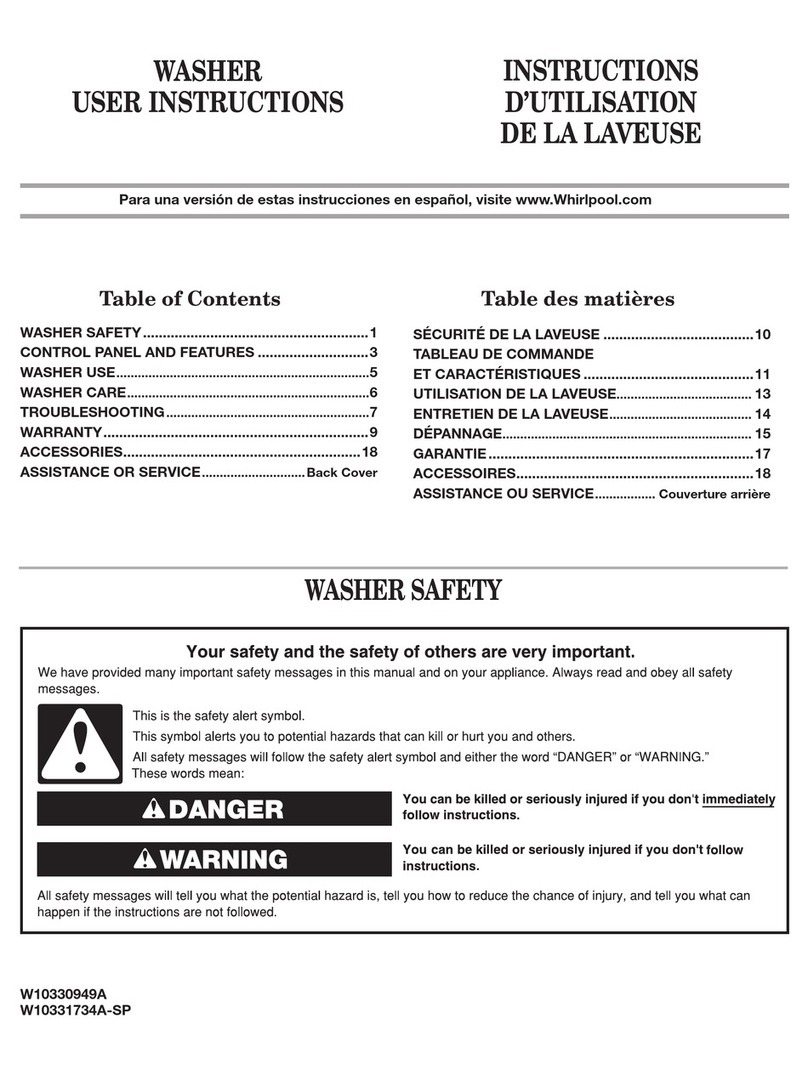
Admiral
Admiral ATW4475VQ1 User manual

Admiral
Admiral ATW4676BQ1 User manual
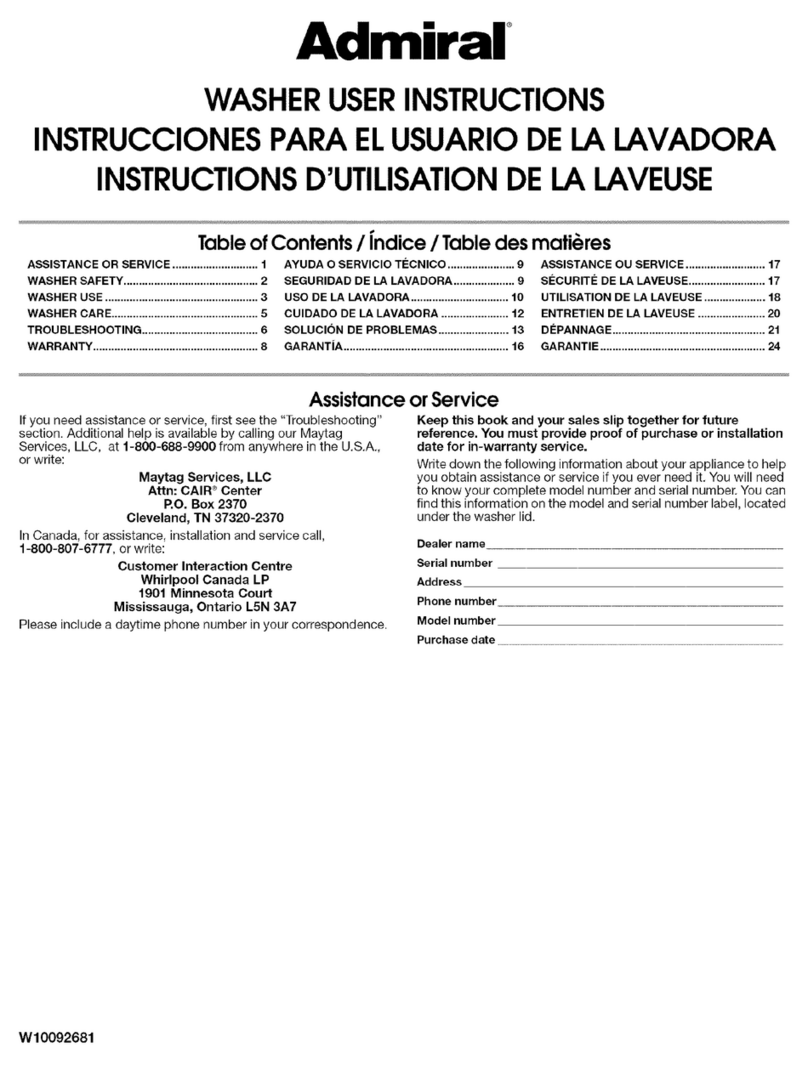
Admiral
Admiral W10092681 User manual

Admiral
Admiral ATW4475XQ0 User manual
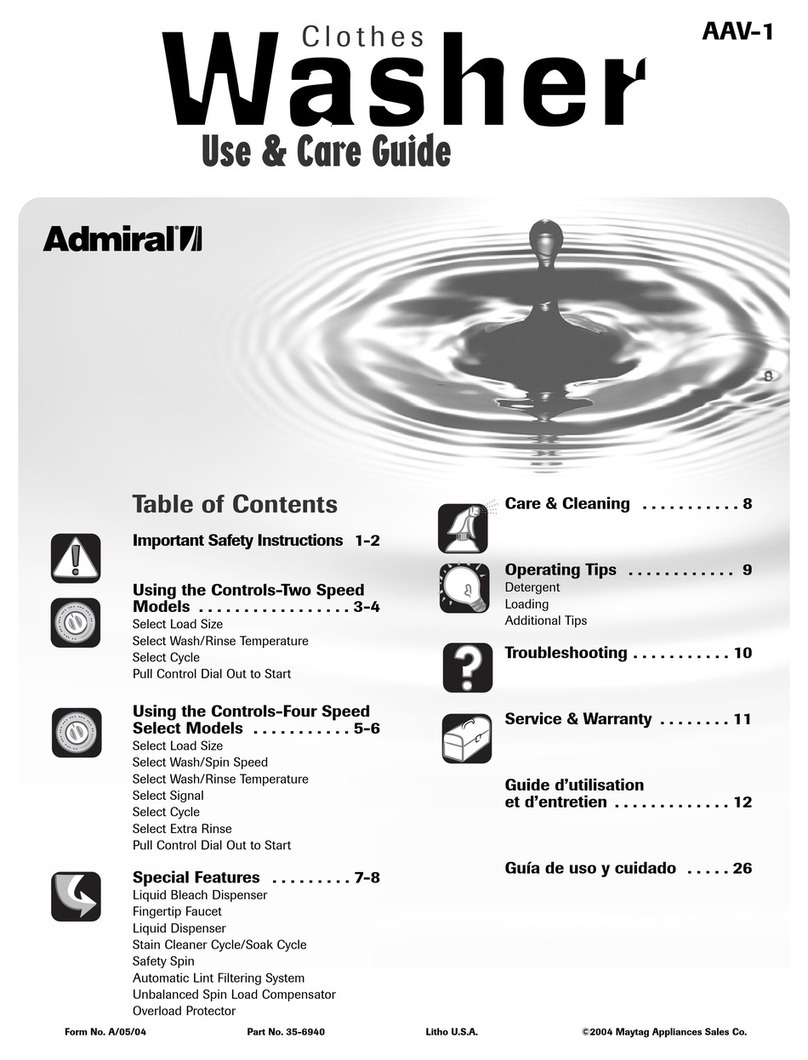
Admiral
Admiral AAV-1 User manual
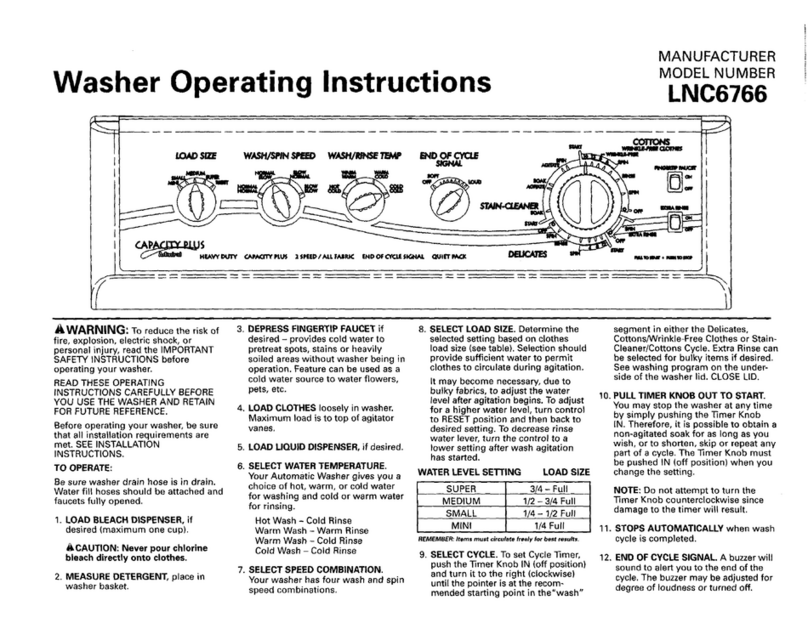
Admiral
Admiral LNC6766 User manual
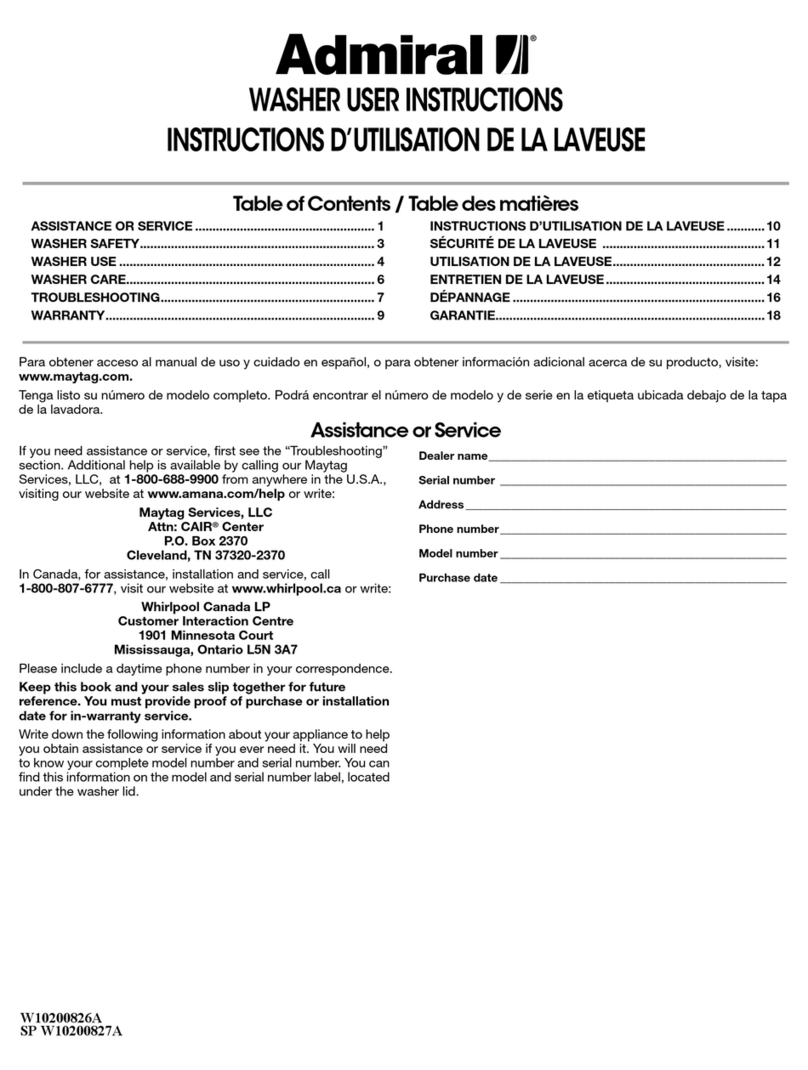
Admiral
Admiral ATW4475VQ0 User manual

